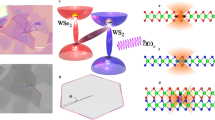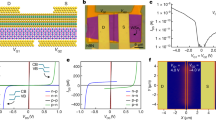Abstract
Strong electronic interactions can result in novel particle–antiparticle (electron–hole, e–h) pair generation effects1, which may be exploited to enhance the photoresponse of nanoscale optoelectronic devices. Highly efficient e–h pair multiplication has been demonstrated in several important nanoscale systems, including nanocrystal quantum dots2,3,4,5,6, carbon nanotubes7,8,9 and graphene10,11,12,13. The small Fermi velocity and nonlocal nature of the effective dielectric screening in ultrathin layers of transition-metal dichalcogenides (TMDs) indicates that e–h interactions are very strong14,15,16, so high-efficiency generation of e–h pairs from hot electrons is expected. However, such e–h pair multiplication has not been observed in 2D TMD devices. Here, we report the highly efficient multiplication of interlayer e–h pairs in 2D semiconductor heterostructure photocells. Electronic transport measurements of the interlayer I–VSD characteristics indicate that layer-indirect e–h pairs are generated by hot-electron impact excitation at temperatures near T = 300 K. By exploiting this highly efficient interlayer e–h pair multiplication process, we demonstrate near-infrared optoelectronic devices that exhibit 350% enhancement of the optoelectronic responsivity at microwatt power levels. Our findings, which demonstrate efficient carrier multiplication in TMD-based optoelectronic devices, make 2D semiconductor heterostructures viable for a new class of ultra-efficient photodetectors based on layer-indirect e–h excitations.
This is a preview of subscription content, access via your institution
Access options
Access Nature and 54 other Nature Portfolio journals
Get Nature+, our best-value online-access subscription
$29.99 / 30 days
cancel any time
Subscribe to this journal
Receive 12 print issues and online access
$259.00 per year
only $21.58 per issue
Buy this article
- Purchase on Springer Link
- Instant access to full article PDF
Prices may be subject to local taxes which are calculated during checkout





Similar content being viewed by others
References
Dirac, P. A. M. The Principles of Quantum Mechanics (Oxford University Press, 1930).
Schaller, R. D. & Klimov, V. I. High efficiency carrier multiplication in PbSe nanocrystals: implications for solar energy conversion. Phys. Rev. Lett. 92, 1866011 (2004).
Ellingson, R. J. et al. Highly efficient multiple exciton generation in colloidal PbSe and PbS quantum dots. Nano Lett. 5, 865–871 (2005).
Semonin, O. E. et al. Peak external photocurrent quantum efficiency exceeding 100% via MEG in a quantum dot solar cell. Science 334, 1530–1533 (2011).
Gachet, D., Avidan, A., Pinkas, I. & Oron, D. An upper bound to carrier multiplication efficiency in type II colloidal quantum dots. Nano Lett. 10, 164–170 (2010).
Cirloganu, M. C. et al. Enhanced carrier multiplication in engineered quasi-type-II quantum dots. Nat. Commun. 5, 4148 (2014).
Ueda, A., Matsuda, K., Tayagaki, T. & Kanemitsu, Y. Carrier multiplication in carbon nanotubes studied by femtosecond pump–probe spectroscopy. Appl. Phys. Lett. 92, 2331051 (2008).
Gabor, N. M., Bosnick, Z. K., Park, J. & McEuen, P. L. Extremely efficient multiple electron–hole pair generation in carbon nanotube photodiodes. Science 325, 1367–1371 (2009).
Wang, S., Khafizov, M., Tu, X., Zheng, M. & Krauss, T. D. Multiple exciton generation in single-walled carbon nanotubes. Nano Lett. 10, 2381–2386 (2010).
Plotzing, T. et al. Experimental verification of carrier multiplication in graphene. Nano Lett. 14, 5371–5375 (2014).
Brida, D. et al. Ultrafast collinear scattering and carrier multiplication in graphene. Nat. Commun. 4, 1987 (2013).
Wendler, F., Knorr, A. & Malic, E. Carrier multiplication in graphene under Landau quantization. Nat. Commun. 5, 3703 (2014).
Wu, S. et al. Multiple hot-carrier collection in photo-excited graphene Moiré superlattices. Sci. Adv. 2, e1600002 (2016).
Wu, F., Qu, F. & MacDonald, A. H. Exciton band structure of monolayer MoS2 . Phys. Rev. B 91, 0753101 (2015).
Chernikov, A. et al. Exciton binding energy and nonhydrogenic Rydberg series in monolayer WS2 . Phys. Rev. Lett. 113, 0768021 (2014).
Keldysh, L. V. Coulomb interaction in thin semiconductor and semimetal films. JETP Lett. 29, 658–660 (1979).
Hong, X. et al. Ultrafast charge transfer in atomically thin MoS2/WS2 heterostructures. Nat. Nanotech. 9, 682–686 (2014).
Rivera, P. et al. Valley-polarized exciton dynamics in a 2D semiconductor heterostructure. Science 351, 688–691 (2016).
Rivera, P. et al. Observation of long-lived interlayer excitons in monolayer MoSe2–WSe2 heterostructures. Nat. Commun. 6, 6242 (2015).
Rigosi, A. F., Hill, H. M., Li, Y., Chernikov, A. & Heinz, T. F. Probing interlayer interactions in transition metal dichalcogenide heterostructures by optical spectroscopy: MoS2/WS2 and MoSe2/WSe2 . Nano Lett. 15, 5033–5038 (2015).
Calman, E. V. et al. Control of excitons in multi-layer van der Waals heterostructures. Appl. Phys. Lett. 108, 1019011 (2016).
Furchi, M. M., Pospischil, A. A., Libisch, F., Burgdörfer, J. & Mueller, T. Photovoltaic effect in an electrically tunable van der Waals heterojunction. Nano Lett. 14, 4785–4791 (2014).
Nourbakhsh, A., Zubair, A., Dresselhaus, M. & Palacios, T. Transport properties of a MoS2/WSe2 heterojunction transistor and its potential for application. Nano Lett. 16, 1359–1366 (2016).
Sze, M. & Ng, K. K. Physics of Semiconductor Devices (Wiley-Interscience, 1963).
Shockley, W. & Queisser, H. J. Detailed balance limit of efficiency of p–n junction solar cells. J. Appl. Phys. 32, 510–519 (1960).
Movva, H. C. P. et al. High-mobility holes in dual-gated WSe2 field-effect transistors. ACS Nano 9, 10402–10410 (2015).
Lee, C. L. et al. Atomically thin p–n junctions with van der Waals heterointerfaces. Nat. Nanotech. 9, 676–681 (2014).
Withers, F. et al. Light-emitting diodes by band-structure engineering in van der Waals heterostructures. Nat. Mater. 14, 301–306 (2015).
High, A. A., Novitskaya, E. E., Butov, L. V., Hanson, M. & Gossard, A. C. Control of exciton fluxes in an excitonic integrated circuit. Science 321, 229–231 (2008).
Jones, A. M. et al. Spin–layer locking effects in optical orientation of exciton spin in bilayer WSe2 . Nat. Phys. 10, 130–134 (2014).
Kresse, G. & Furthmüller, J. Efficient iterative schemes for ab initio total-energy calculations using a plane-wave basis set. Phys. Rev. B 54, 11169–11186 (1996).
Kresse, G. & Hafner, J. Ab initio molecular dynamics for liquid metals. Phys. Rev. B 47, 558–561 (1993).
Kresse, G. & Furthmüller, J. Efficiency of ab-initio total energy calculations for metals and semiconductors using a plane-wave basis set. Comput. Mater. Sci. 6, 15–50 (1996).
Blöchl, P. E. Projector augmented-wave method. Phys. Rev. B 50, 17953–17979 (1994).
Perdew, J. P. et al. Atoms, molecules, solids, and surfaces: applications of the generalized gradient approximation for exchange and correlation. Phys. Rev. B 46, 6671–6687 (1992).
Wang, Y. & Perdew, J. P. Correlation hole of the spin-polarized electron gas, with exact small-wave-vector and high-density scaling. Phys. Rev. B 44, 13298–13307 (1991).
Kresse, G. & Joubert, D. From ultrasoft pseudopotentials to the projector augmented-wave method. Phys. Rev. B 59, 1758–1775 (1999).
Grimme, S. Semiempirical GGA-type density functional constructed with a long-range dispersion correction. J. Comput. Chem. 27, 1787 (2006).
Acknowledgements
This work was made possible by support from SHINES, an Energy Frontier Research Center funded by the US Department of Energy, Office of Science, Basic Energy Sciences under award no. SC0012670. N.M.G. and F.B. acknowledge support from the Air Force Office of Scientific Research, Biosystems Directorate award no. FA9550-16-1-0216. N.M.G. acknowledges a Cottrell Scholar Award and support from the National Science Foundation Division of Materials Research CAREER award no. 1651247. M.G., S.S. and R.K.L. acknowledge support from SHINES. Nanofabrication and Raman characterization was performed at the Center for Nanoscale Science and Engineering (CNSE) at the University of California Riverside. DFT calculations were supported by the SHINES centre. This work used the Extreme Science and Engineering Discovery Environment (XSEDE), which is supported by National Science Foundation grant no. ACI-1053575. V.A. acknowledges support from the National Science Foundation Division of Materials Research under award no. 1506707.
Author information
Authors and Affiliations
Contributions
N.M.G., F.B. and M.G. conceived and designed the experiment. F.B. fabricated the heterostructure devices, and conducted Raman, photoluminescence and photocurrent characterization. M.G. and F.B. performed transport and photocurrent measurements and, in cooperation with V.A., conducted data analysis. N.M.G., V.A. and F.B. developed the interlayer transport model. S.S. and R.K.L. conducted DFT band-structure calculations. All authors discussed the results, analysed data and wrote the manuscript.
Corresponding author
Ethics declarations
Competing interests
The authors declare no competing financial interests.
Supplementary information
Supplementary information
Supplementary information (PDF 2665 kb)
Rights and permissions
About this article
Cite this article
Barati, F., Grossnickle, M., Su, S. et al. Hot carrier-enhanced interlayer electron–hole pair multiplication in 2D semiconductor heterostructure photocells. Nature Nanotech 12, 1134–1139 (2017). https://doi.org/10.1038/nnano.2017.203
Received:
Accepted:
Published:
Issue Date:
DOI: https://doi.org/10.1038/nnano.2017.203
This article is cited by
-
Photocurrent as a multiphysics diagnostic of quantum materials
Nature Reviews Physics (2023)
-
Pressure-induced superconductivity in topological heterostructure (PbSe)5(Bi2Se3)6
Science China Materials (2023)
-
Electrically tunable two-dimensional heterojunctions for miniaturized near-infrared spectrometers
Nature Communications (2022)
-
Hot carrier photovoltaics in van der Waals heterostructures
Nature Reviews Physics (2021)
-
Electronic Properties of Armchair Black Phosphorene Nanoribbons Edge-Modified by Transition Elements V, Cr, and Mn
Nanoscale Research Letters (2019)



